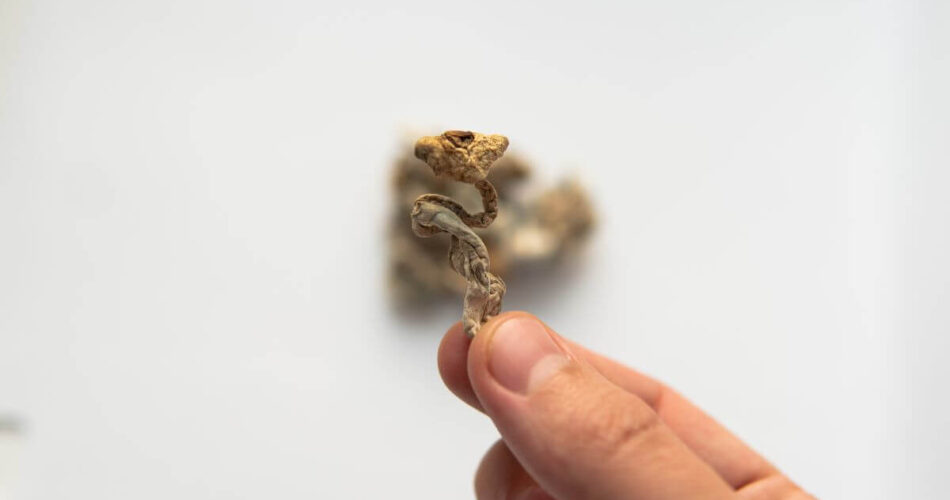Pluteus cyanopus is a mushroom with a soft, white, squishy rounded cap. It is one of the most difficult types of mushrooms to identify on sight. Here are some of the most interesting facts you need to know about Pluteus cyanopus mushrooms. Join the reading!
Fortunately, there are many things about this particular species that make it stand out from the rest. Let’s dive into the details right away!
Habitat
The Pluteus cyanopus is native to North America, Africa and Europe, where it grows on decaying wood, such as stumps and logs; occasionally it will fruit from buried roots. It is found in both deciduous and coniferous forests throughout the year. This species has a lilac-gray cap when young, but becomes more pinkish as it matures. The gills are initially white, but become lilac and finally brown with age. The spore print is also brown. The flesh of P. cyanopus has a weak odor that some people find unpleasant. No ring to be seen.
Growing Pluteus Cyanopus at Home
In order to grow Pluteus cyanopus mushrooms at home, you will need a piece of wood that the mushrooms typically grow on (oak), sterilized sawdust containing a high percentage of oak, and a culture of Pluteus cyanopus mycelium. You will also need a pressure cooker or autoclave in order to sterilize the sawdust and prevent contamination from other fungi.
After you have these things prepared, you will mix your culture with the sterilized sawdust, keeping it cool to prevent overheating which would kill the mycelium. Place the mixture inside a bag or jar along with a filter patch made out of cloth or paper in order to let air through but prevent dust from entering. Then place this container in a warm shaded area until your mushroom patch is colonized by the mycelium, and you are ready to proceed to step two which is the fruiting process.
Fruiting Process
Once you are ready to begin the fruiting process, you will need to take your container out of storage and place it in a cool, dark environment with plenty of fresh air flowing through it. This is known as “spawning”, and once this step has been completed successfully and the mushrooms are beginning to appear, there is almost nothing left for you to do except harvest them when they reach their prime!
Shrooms. Pros and Cons
There are few known health benefits to Pluteus cyanopus, though research has shown that it contains some compounds that might help fight inflammation, which could be useful to those with arthritis. More research needs to be done before any conclusions can be drawn. The mushroom also contains a few potentially harmful toxins, so it should be consumed with caution and never eaten raw.
The Effects of Pluteus Cyanopus
The active ingredient in P. cyanopus is psilocybin, which is a hallucinogen that can cause powerful changes in perception and mood. When consumed, the effects of P. cyanopus can be felt within 15 to 60 minutes. The experience typically lasts 4 to 6 hours, though some people may continue to feel the effects for up to 24 hours.
The effects of Pluteus cyanopus are often described as euphoric, with users experiencing feelings of intense happiness and bliss. Other common effects include hallucinations, enhanced senses, increased creativity, and introspection. However, there can also be unpleasant side effects such as anxiety, confusion, paranoia, and panic attacks in some cases.
Dosage
As with any psychedelic substance, it is important to start with a low dosage (perhaps 0.03 oz) when using Pluteus cyanopus and only gradually increase your dose if you do not feel its effects at first. This is because the effects of P. cyanopus can be overwhelming and even unpleasant if you take too much.
Similar Posts:
- Pluteus Brunneidiscus: Mushroom Description & Habitat. Does Pluteus Brunneidiscus Contain Psilocybin?
- Pluteus Salicinus Mushroom: About the Willow Shield Shroom (Knackers Crumpet)
- Pluteus Glaucus: Rare Mushrooms Species
- Pluteus Americanus Mushroom: Characteristics, Habitat, Morphology, Growth, Legality & Benefits
- How Long Does It Take for Shrooms to Grow? All About Growing Mushrooms
- Pluteus Nigroviridis: Is P. Nigroviridis Potent? All You Should Know About Shrooms
- Growing Psilocybe Cyanescens Indoors – Magic Mushrooms in the Comfort of Your Home





